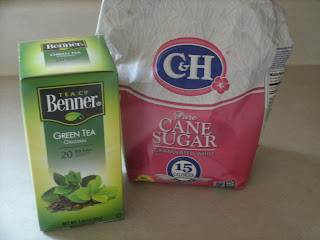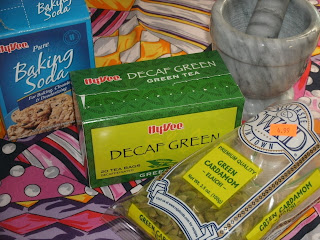Have a cup of Christmas
I'm skipping ahead just a little bit because of a Central American holiday tradition. The hibiscus flowers are in bloom, and it's tea season. In this part of the world, hibiscus tea is known as "sorrel" instead of "bissap".
While my research on the tea of North America is not complete, I found that several countries make sorrel for Christmas.
Trinidad and Tobago, the southern most Caribbean islands. They gained their independence from the UK in 1962. They are a continuation of the Andes mountains from Venezuela. They have a tropical climate, and temperatures vary widely between day and night. They used to grow a lot of sugarcane, but the last of the sugarcane estates was closed. Cocoa and coffee are also export crops. Most of the population is rural, and is made up of people from Africa, East Indian, and mixed race.
Saint Vincent and the Grenadines, are part of the Lesser Antilles in the eastern Caribbean Sea. These islands gained their independence in 1979. The climate there is also tropical maritime, and is in the path of the northeast trade winds. The urban to rural ratio is about 50/50.
Nicaragua didn't have anything specific about tea they drink there, but they had a video on hibiscus tea production, so they are getting lumped in here, too. They are the largest Central American republic. They have been colonized by both the Spanish and the British in their history, and the people are of mixed Indian and European heritage. I haven't fact checked this memory, but I do recall hearing a story on NPR about how starting the war to overthrow the government in Nicaragua was how the CIA got it's start (or at least proved its effectiveness). There are low mountains, and volcanoes in the area. The climate there is described as "cooler" and wetter. Considering their location, cooler is a relative term.
I found several different variations on sorrel, so I chose what sounded best to me.
I used hibiscus flowers, cloves, cinnamon, and orange peel. Everyone agreed on the hibiscus flowers and "orange zest". I put the orange zest in quotes because I normally think of orange zest being the very outermost bit of the peel. The white pith has a reputation for being bitter, and is normally not included in the zest of the fruit, but all the references I found just showed a hunk or two of orange peel floating in the tea - white pith included.
So I took the leap of faith and tossed in a couple of pieces of orange peel. All in all, I used about 3 cups of water, 2 tablespoons of dried hibiscus, 4 cloves, and few pieces of cinnamon. I set the timer to steep 5 minutes. Then I got hung up doing something else, and didn't strain the concoction for a few more minutes after that.
You end up with a festive red drink. It matches my "winter berry" pattern china well. It is traditionally served iced (in the tropics, remember), and with a lot of sugar. I mean, people in the videos start out with adding a bunch of sugar, brewing, straining, and then adding more sugar. I drank mine warm. I don't want to drink it hot hot hot because it is very acidic, and I figure slightly cooler is better for my teeth (minus all the sugar is also better for my teeth - along with the rest of me).
The verdict? The orange tastes great in this tea. It adds just a little hint of citrus. It reminds me of orange flower water, but less aggressive and more balanced in flavor. I can understand why you would serve this at a party, it is a nicely flavored drink, and would work well being served out of a punch bowel. It also makes good use of a part of the orange that is usually discarded. In fact, I put the rest of the orange peel I didn't use into the fridge for future reference.
While my research on the tea of North America is not complete, I found that several countries make sorrel for Christmas.
Trinidad and Tobago, the southern most Caribbean islands. They gained their independence from the UK in 1962. They are a continuation of the Andes mountains from Venezuela. They have a tropical climate, and temperatures vary widely between day and night. They used to grow a lot of sugarcane, but the last of the sugarcane estates was closed. Cocoa and coffee are also export crops. Most of the population is rural, and is made up of people from Africa, East Indian, and mixed race.
Saint Vincent and the Grenadines, are part of the Lesser Antilles in the eastern Caribbean Sea. These islands gained their independence in 1979. The climate there is also tropical maritime, and is in the path of the northeast trade winds. The urban to rural ratio is about 50/50.
Nicaragua didn't have anything specific about tea they drink there, but they had a video on hibiscus tea production, so they are getting lumped in here, too. They are the largest Central American republic. They have been colonized by both the Spanish and the British in their history, and the people are of mixed Indian and European heritage. I haven't fact checked this memory, but I do recall hearing a story on NPR about how starting the war to overthrow the government in Nicaragua was how the CIA got it's start (or at least proved its effectiveness). There are low mountains, and volcanoes in the area. The climate there is described as "cooler" and wetter. Considering their location, cooler is a relative term.
I found several different variations on sorrel, so I chose what sounded best to me.
I used hibiscus flowers, cloves, cinnamon, and orange peel. Everyone agreed on the hibiscus flowers and "orange zest". I put the orange zest in quotes because I normally think of orange zest being the very outermost bit of the peel. The white pith has a reputation for being bitter, and is normally not included in the zest of the fruit, but all the references I found just showed a hunk or two of orange peel floating in the tea - white pith included.
So I took the leap of faith and tossed in a couple of pieces of orange peel. All in all, I used about 3 cups of water, 2 tablespoons of dried hibiscus, 4 cloves, and few pieces of cinnamon. I set the timer to steep 5 minutes. Then I got hung up doing something else, and didn't strain the concoction for a few more minutes after that.
You end up with a festive red drink. It matches my "winter berry" pattern china well. It is traditionally served iced (in the tropics, remember), and with a lot of sugar. I mean, people in the videos start out with adding a bunch of sugar, brewing, straining, and then adding more sugar. I drank mine warm. I don't want to drink it hot hot hot because it is very acidic, and I figure slightly cooler is better for my teeth (minus all the sugar is also better for my teeth - along with the rest of me).
The verdict? The orange tastes great in this tea. It adds just a little hint of citrus. It reminds me of orange flower water, but less aggressive and more balanced in flavor. I can understand why you would serve this at a party, it is a nicely flavored drink, and would work well being served out of a punch bowel. It also makes good use of a part of the orange that is usually discarded. In fact, I put the rest of the orange peel I didn't use into the fridge for future reference.






I'll bet it smelled very Christmassy with the orange and spices.
ReplyDeleteIt did, and so do the leftovers today.
DeleteI really liked your Information. Keep up the good work. Organic Tea Nespresso
ReplyDelete